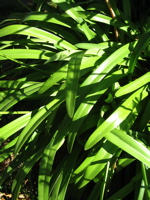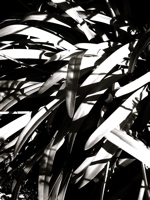|
The World is Full of Different Shapes
What are shapes and where do they originate? How do you decide which of them to use in your designs? . A simplified definition is... ... a self contained area that has an outline. It can be of geometric or organic form, and can be either positive or negative. A positive automatically creates a negative. Draw a line that meets up with its starting point. Try it now on a piece of paper. Draw a circle. You finish at the same point as you started, and what have you created> You guessed it!. When you talk about shapes, the first to usually enter your mind are the circle, square, triangle, hexagon and other well-known geometric images. But there are many more varied and interesting examples to be found. We find them in everything around us. The most obvious are those of buildings, cars, people and other items we see every day. We also see natural shape in trees, leaves, flowers, rocks and other parts of nature.


Look at the photo of these leaves. You will find both positive and negative shapes in this photo, both of which can be very useful in designing patterns. The lesson here is that often the negative shape creates equal if not more interest than the positive areas. If you are having trouble identifying any negative areas, just squint and they will start to show as the white bits. You will notice how it is easier to differentiate the positive and negative areas in the black and white photo. Try this little exercise. It really helps you transfer natural elements into basic modules, and is a great source of inspiration for many designers. Find a seed pod (maybe a spent rose, a gum nut or something similar.) Do a tonal sketch of this object. Next rule up a square -10 x 10 centimeter is a good size. Identify shapes from the original drawing, simplify them, repeat them and make them into a 2 dimensional pattern using only black and white.
When you are finished, look at the positive (black) areas, then really focus on the white negative areas. In my example, I find that the negative sections start to form new flowers and therefore give me new modules to work with. What do you see? Another great source of inspiration for analyzing and using shape is the Cubist Art Movement of the early 20th century. In 1907 Pablo Picasso started painting faces and bodies as if they were made up of solid components. He had been influenced by African sculpture, resulting in him depicting shapes in simple, geometric forms. He discovered that the human head and body could be broken down into and be represented by cubes, triangles and spheres. Hence the name Cubism. The simplest way to describe Picasso's art is that he took his subject apart, broke it down into components, and then put it back together in a new way. This simple principle is a great one to remember when you are having difficulty with a page layout for scrap-booking. The page Map is made up of basic areas - look at them, cut them out -they are the elements of the page, then re-arrange them to create a new page map. Turn them sideways, upside down, mirror image them - whatever you like, and you will eventually find something that works for that particular project. Pablo Picasso and his followers invented many different ways of painting their subjects, but they were always analytical. They were interested in discovering new ways of looking at a subject. This attitude is a great one to keep in mind if you want to create truly original projects. Apply the principle of analyse, break down, re-arrange and compose and you will find ideas flowing freely. Through their painting experiments, Picasso and fellow Cubist painter Braque, discovered Collage. This is a French word meaning "paste together", and the art of collage is a delightful and exciting way to create incredibly original stamped items like ATC's, cards and altered books. There are many more related areas on how the manipulation of shape can influence the designs and outcomes of your projects. One of these is how to control pictorial depth by using an arrangement of planes. Visit my site often to discover new links an related topics, as they are constructed.
|







